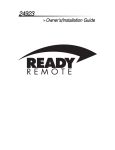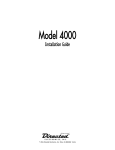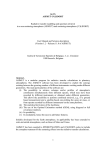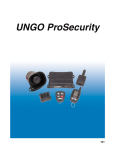Download DEI 556U Installation guide
Transcript
165B ➤Owner’s/Installation Guide limited lifetime consumer warranty Directed Electronics, Inc. (hereinafter "Directed") promises to the original purchaser to repair or replace with a comparable reconditioned Directed DIY remote start unit if this Directed DIY remote start unit (hereinafter "Unit"), excluding without limitation, any remote transmitters or associated accessories, proves defective in materials or workmanship under normal use for the life of the vehicle which the Unit is originally installed. During this period, so long as the Unit remained installed in the original vehicle, Directed will at its option, repair or replace this Unit if it is proved defective in workmanship or material PROVIDED the Unit is returned to Directed's warranty department at One Viper Way, Vista, CA 92081, along with $20 postage and handling fee, a bill of sale or other dated proof of purchase bearing the following information: Date of purchase, name and location of the merchant who sold the Unit, and product description. This warranty does not cover labor costs for the removal or reinstallation of the Unit. This warranty is non-transferable and does not apply to any Unit that has been modified or used in a manner contrary to its intended purpose, and this warranty does not cover damage to any Unit caused by installation or removal of the Unit. This warranty is void if the Unit has been damaged by accident or unreasonable use, neglect, improper service or other causes not arising out of defects in materials or workmanship. Directed makes no warranty against theft of a vehicle or its contents. THE FOREGOING WARRANTY IS THE EXCLUSIVE PRODUCT WARRANTY, OTHERWISE, ALL WARRANTIES INCLUDING BUT NOT LIMITED TO EXPRESS WARRANTY, IMPLIED WARRANTY, WARRANTY OF MERCHANTABILITY, OR FITNESS FOR A PARTICULAR PURPOSE ARE EXPRESSLY EXCLUDED AND DISCLAIMED TO THE MAXIMUM EXTENT ALLOWED BY LAW, AND DIRECTED NEITHER ASSUMES NOR AUTHORIZES ANY PERSON TO ASSUME FOR IT ANY LIABILITY IN CONNECTION WITH THE SALE OF THE PRODUCT. DIRECTED HAS ABSOLUTELY NO LIABILITY FOR ANY AND ALL ACTS OF THIRD PARTIES INCLUDING ITS AUTHORIZED DEALERS OR INSTALLERS. SOME STATES DO NOT ALLOW THE LIMITATION ON HOW LONG AN IMPLIED WARRANTY LASTS, SO THE ABOVE LIMITATION MAY NOT APPLY TO YOU. LIMITATION OF DAMAGES AND LIABILITY. CONSUMER'S REMEDY IS LIMITED TO REPAIR OR REPLACEMENT OF THE UNIT, AND IN NO EVENT SHALL DIRECTED'S LIABILITY EXCEED THE PURCHASE PRICE OF THE UNIT. IN ANY EVENT, DIRECTED SHALL NOT BE LIABLE FOR ANY DAMAGES INCLUDING, BUT NOT LIMITED TO, ANY DIRECT, INDIRECT, INCIDENTAL, SPECIAL, PUNITIVE OR CONSEQUENTIAL DAMAGES, LOST PROFITS, LOST SAVINGS, OR, TO THE EXTENT ALLOWED BY APPLICABLE LAW, DAMAGES RESULTING FROM DEATH OR INJURY ARISING OUT OF © 2004 Directed Electronics, Inc. i OR IN CONNECTION WITH THE INSTALLATION, USE, IMPROPER USE, OR INABILITY TO USE, THE PRODUCT, EVEN IF THE PARTY HAS BEEN ADVISED OF THE POSSIBILITY OF SUCH DAMAGES. SOME STATES DO NOT ALLOW THE EXCLUSION OF LIMITATION OF INCIDENTAL OR CONSEQUENTIAL DAMAGES, SO THE ABOVE LIMITATIONS OR EXCLUSION MAY NOT APPLY TO YOU. THE CONSUMER AGREES AND CONSENTS THAT ALL DISPUTES BETWEEN THE CONSUMER AND DIRECTED SHALL BE RESOLVED IN ACCORDANCE WITH CALIFORNIA LAWS IN SAN DIEGO COUNTY, CALIFORNIA. IMPORTANT NOTE: This product warranty is automatically void if its date code or serial number is defaced, missing, or altered. This warranty will not be valid unless you have completed the warranty card and mailed it to Directed Electronics, Inc. within 10 days after purchase to the address listed on the warranty registration card. Make sure you have all of the following information from your dealer: A clear copy of the sales receipt, showing the following: ➤ ➤ ➤ ii Date of purchase Authorized dealer's company name and address Item number © 2004 Directed Electronics, Inc. table of contents limited lifetime consumer warranty . . . . . . . . . . . . . . . . . . . . . . . . . . . . . . . . . . . . . . . . i what is included . . . . . . . . . . . . . . . . . . . . . . . . . . . . . . . . . . . . . . . . . . . . . . . . . . . . . . 3 installation tools . . . . . . . . . . . . . . . . . . . . . . . . . . . . . . . . . . . . . . . . . . . . . . . . . . . . . . 3 important information . . . . . . . . . . . . . . . . . . . . . . . . . . . . . . . . . . . . . . . . . . . . . . . . . 4 system maintenance . . . . . . . . . . . . . . . . . . . . . . . . . . . . . . . . . . . . . . . . . . . . . . 4 your warranty . . . . . . . . . . . . . . . . . . . . . . . . . . . . . . . . . . . . . . . . . . . . . . . . . . . 4 fcc/id notice . . . . . . . . . . . . . . . . . . . . . . . . . . . . . . . . . . . . . . . . . . . . . . . . . . . . 5 warning! safety first . . . . . . . . . . . . . . . . . . . . . . . . . . . . . . . . . . . . . . . . . . . . . . . . . . . 5 primary harness (H/1),8-pin connector . . . . . . . . . . . . . . . . . . . . . . . . . . . . . . . . . . . . 8 relay wires 6-connectors . . . . . . . . . . . . . . . . . . . . . . . . . . . . . . . . . . . . . . . . . . . . . . . . 8 using LED test probe . . . . . . . . . . . . . . . . . . . . . . . . . . . . . . . . . . . . . . . . . . . . . . . . . . 9 installation . . . . . . . . . . . . . . . . . . . . . . . . . . . . . . . . . . . . . . . . . . . . . . . . . . . . . . . . . 10 step 1 . . . . . . . . . . . . . . . . . . . . . . . . . . . . . . . . . . . . . . . . . . . . . . . . . . . . . . . . 10 step 2 . . . . . . . . . . . . . . . . . . . . . . . . . . . . . . . . . . . . . . . . . . . . . . . . . . . . . . . . 11 step 3 . . . . . . . . . . . . . . . . . . . . . . . . . . . . . . . . . . . . . . . . . . . . . . . . . . . . . . . . 14 step 4 . . . . . . . . . . . . . . . . . . . . . . . . . . . . . . . . . . . . . . . . . . . . . . . . . . . . . . . . 15 step 5 . . . . . . . . . . . . . . . . . . . . . . . . . . . . . . . . . . . . . . . . . . . . . . . . . . . . . . . . 18 step 6 . . . . . . . . . . . . . . . . . . . . . . . . . . . . . . . . . . . . . . . . . . . . . . . . . . . . . . . . 19 step 7 . . . . . . . . . . . . . . . . . . . . . . . . . . . . . . . . . . . . . . . . . . . . . . . . . . . . . . . . 22 step 8 . . . . . . . . . . . . . . . . . . . . . . . . . . . . . . . . . . . . . . . . . . . . . . . . . . . . . . . . 23 step 9 . . . . . . . . . . . . . . . . . . . . . . . . . . . . . . . . . . . . . . . . . . . . . . . . . . . . . . . . 24 step 10 . . . . . . . . . . . . . . . . . . . . . . . . . . . . . . . . . . . . . . . . . . . . . . . . . . . . . . . 25 transmitter functions . . . . . . . . . . . . . . . . . . . . . . . . . . . . . . . . . . . . . . . . . . . . . . . . . 26 standard configuration . . . . . . . . . . . . . . . . . . . . . . . . . . . . . . . . . . . . . . . . . . . 26 Control Module Programming . . . . . . . . . . . . . . . . . . . . . . . . . . . . . . . . . . . . . . . . . 27 using your system . . . . . . . . . . . . . . . . . . . . . . . . . . . . . . . . . . . . . . . . . . . . . . . . . . . 28 warning! safety first . . . . . . . . . . . . . . . . . . . . . . . . . . . . . . . . . . . . . . . . . . . . . . 28 remote start . . . . . . . . . . . . . . . . . . . . . . . . . . . . . . . . . . . . . . . . . . . . . . . . . . . 30 timer mode . . . . . . . . . . . . . . . . . . . . . . . . . . . . . . . . . . . . . . . . . . . . . . . . . . . . 31 pit stop mode . . . . . . . . . . . . . . . . . . . . . . . . . . . . . . . . . . . . . . . . . . . . . . . . . . . . . . . 32 code hopping ® re-synchronize . . . . . . . . . . . . . . . . . . . . . . . . . . . . . . . . . . . . . . . . . 33 system expansion items . . . . . . . . . . . . . . . . . . . . . . . . . . . . . . . . . . . . . . . . . . . . . . . 34 troubleshooting . . . . . . . . . . . . . . . . . . . . . . . . . . . . . . . . . . . . . . . . . . . . . . . . . . . . . 34 glossary of terms . . . . . . . . . . . . . . . . . . . . . . . . . . . . . . . . . . . . . . . . . . . . . . . . . . . . 36 wiring quick reference guide . . . . . . . . . . . . . . . . . . . . . . . . . . . . . . . . . . . . . . . . . . . 37 notes . . . . . . . . . . . . . . . . . . . . . . . . . . . . . . . . . . . . . . . . . . . . . . . . . . . . . . . . . . . . . 39 quick reference guide . . . . . . . . . . . . . . . . . . . . . . . . . . . . . . . . . . . . . . . . . . . . . . . . . 45 © 2004 Directed Electronics, Inc. 1 2 © 2004 Directed Electronics, Inc. what is included Control Module ➤ One 4-Button Transmitter ➤ 8-Pin Main H/1 Harness ➤ 6-Relay Wires ➤ Shutdown Toggle Switch ➤ Hood Pin Switch ➤ 10 feet of Black Electrical Tape ➤ 6 Six inch Zip Ties ➤ LED Tester ➤ Razor Knife ➤ CDROM—Do-It-Yourself Installation Video Additional parts may be required (such as relays or immobilizer). ➤ installation tools ➤ ➤ ➤ ➤ ➤ ➤ ➤ ➤ ➤ Digital Multi-Meter Drill 9 /32 and 5/16 Drill Bits Screwdrivers (Phillips and Flathead) Wire Stripper Solder Iron Electrical Tape Pliers Crimping Tool note: The installation tools listed above may be optional and those required will vary depending on your vehicle. © 2004 Directed Electronics, Inc. 3 important information Congratulations on the purchase of your remote start system. This system will allow convenient remote start of your vehicle. Properly installed, this system will provide years of trouble-free operation. Please take the time to carefully read this User’s Guide in its entirety and watch the Do-It-Yourself Installation Video (CDROM) prior to installing your system. You can print additional or replacement copies of this manual by accessing the Directed web site at www.boasecurity.com. important! If you are not comfortable working with electronics or unfamiliar with the tools required, please contact your local dealer for advice or ask to have the remote start professionally installed to avoid costly damages. Failure to properly install the remote starter may result in property damage, personal injury, or both. ➜ system maintenance The system requires no specific maintenance. Your transmitter is powered by a miniature 3-volt battery (type CR2032) that will last approximately one year under normal use. When the battery begins to weaken, the operating range will be reduced. ➜ your warranty Your warranty registration must be completely filled out and returned within 10 days of purchase. Your product warranty will not be validated if your warranty registration is not returned. Please note that it is necessary to keep your proof of purchase. 4 © 2004 Directed Electronics, Inc. ➜ fcc/id notice This device complies with Part 15 of FCC rules. Operation is subject to the following conditions: (1) This device may not cause harmful interference, and (2) This device must accept any interference received, including interference that may cause undesirable operation. Changes or modifications not expressly approved by the party responsible for compliance could void the user's authority to operate this device. warning! safety first The following safety warnings must be observed at all times: ➤ When properly installed, this system can start the vehicle via a command signal from the remote control transmitter. Therefore, never operate the system in an area that does not have adequate ventilation. The following precautions are the sole responsibility of the user; however, the following recommendations should be made to all users of this system: 1. Never operate the system in an enclosed or partially enclosed area without ventilation (such as a garage). 2. When parking in an enclosed or partially enclosed area or when having the vehicle serviced, the remote start system must be disabled using the toggle switch. 3. It is the user's sole responsibility to properly handle and keep out of reach from children all remote control © 2004 Directed Electronics, Inc. 5 transmitters to assure that the system does not unintentionally remote start the vehicle. 4. THE USER MUST INSTALL A CARBON MONOXIDE DETECTOR IN OR ABOUT THE LIVING AREA ADJACENT TO THE VEHICLE. ALL DOORS LEADING FROM ADJACENT LIVING AREAS TO THE ENCLOSED OR PARTIALLY ENCLOSED VEHICLE STORAGE AREA MUST AT ALL TIMES REMAIN CLOSED. ➤ Use of this product in a manner contrary to its intended mode of operation may result in property damage, personal injury, or death. Except when performing the Safety Check outlined in this user’s guide, (1) Never remotely start the vehicle with the vehicle in gear, and (2) Never remotely start the vehicle with the keys in the ignition. The user will be responsible for having the neutral safety feature of the vehicle periodically checked, wherein the vehicle must not remotely start while the car is in gear. This testing should be performed by an authorized Directed dealer in accordance with the Safety Check outlined in this product installation guide. If the vehicle starts in gear, cease remote start operation immediately and consult with the Dealer to fix the problem immediately. ➤ After the remote start module has been installed, test the remote start module in accordance with the Safety Check outlined in this installation guide. If the vehicle starts when performing the Neutral Safety Shutdown Circuit test, the remote start unit has not been properly installed. The remote 6 © 2004 Directed Electronics, Inc. start module must be removed or properly reinstalled so that the vehicle does not start in gear. OPERATION OF THE REMOTE START MODULE IF THE VEHICLE STARTS IN GEAR IS CONTRARY TO ITS INTENDED MODE OF OPERATION. OPERATING THE REMOTE START SYSTEM UNDER THESE CONDI TIONS MAY RESULT IN PROPERTY DAMAGE OR PERSONAL INJURY. IMMEDIATELY CEASE THE USE OF THE UNIT AND REPAIR OR DISCONNECT THE INSTALLED REMOTE START MODULE. DIRECTED WILL NOT BE HELD RESPONSIBLE OR PAY FOR INSTALLATION OR REINSTALLATION COSTS. © 2004 Directed Electronics, Inc. 7 primary harness (H/1), 8-pin connector H1/1 BLUE H1/2 VIOLET/WHITE H1/3 BROWN H1/4 GRAY H1/5 BLACK H1/6 WHITE/BLUE H1/7 LT. GREEN/BLACK H1/8 WHITE (-) 200mA Status Output Tachometer Input (optional) (+) Brake Switch Shutdown Input (-) Hood Pin Shutdown Input Ground (-) Remote Start Activation Input Factory Alarm Disarm (-) Parking Light Flash Output (optional) relay wires 6-connectors 8 A VIOLET B RED C ORANGE (+) Output to ACC1 Circuit D PINK (+) Output to IGN1 Circuit E RED F PINK/WHITE(+) (+) Output to Starter Circuit (+) (30A) High Current 12V Input (+) (30A) High Current 12V Input Output to IGN2 Circuit © 2004 Directed Electronics, Inc. using LED test probe note: Do not use this test probe on computerized equipment as damage can result. To use the LED test probe: 1. Remove the protective cover off the probe tip. Save the protective cover for reinstallation on the probe tip when the LED tester is not being used. 2. Connect the Black clip to a good chassis ground. 3. Connect the Red clip to a good +12V source. Both the Red and Green LEDs should be illuminated dimly. 4. If a positive voltage source is probed, the Red LED will illuminate brightly, and the Green LED will extinguish. 5. If a negative source is probed the Green LED will illuminate brightly and the Red LED will extinguish. Alternate procedure to use the LED test probe (only for use on probing positive voltage wires): 1. Remove the protective cover off the probe tip. Save the protective cover for reinstallation on the probe tip when the LED tester is not being used. 2. Connect the Black clip to a good chassis ground. 3. If a positive voltage source is probed, the Red LED will illuminate brightly. © 2004 Directed Electronics, Inc. 9 installation Be sure to read this section thoroughly and view the Do-ItYourself Installation CDROM video in its entirety before starting the installation. Pay special attention to all warnings to prevent personal injury or damage to your vehicle. www.boasecurity.com) to Visit our 24-hour technical Web site (w get a vehicle-specific wiring guide prior to starting this installation. If at any time during the installation you are unable to answer your questions on the Web site, call 1-800-873-1314 for live technical assistance. warning! This system is intended for automatic, fuel-injected vehicles only. Installation in any other vehicle is contrary to its intended use. warning! On vehicles with air bags or supplemental restraint systems (SRS) you may notice a bright yellow tube with small wires in it marked SRS underneath the steering column near the key cylinder. DO NOT tamper or unplug these for any reason to prevent costly damages to your vehicle or personal injury. Tampering may cause unintended deployment of airbags. warning! Verify that the vehicle is set to park and that the parking brake is set before beginning installation. 10 © 2004 Directed Electronics, Inc. ➜ step 1 Ground Wire The BLACK (H1/5) wire on the main 8-pin harness is ground. This wire should be connected to a clean, paint-free area of metal in the drivers kick panel area. First strip back a ¾-inch section of the insulation off the BLACK wire and crimp a ring terminal (not provided) to that wire. Locate a clean, paint-free metal surface in the drivers kick panel. Using a self-tapping screw, drill the screw with the ring terminal to the metal area. Once screwed down, pull on the wire to ensure a good connection. note: More problems are attributed to poor ground connections than any other cause. Take extra care to ensure the ground is a clean metal-to-metal contact and secure. SELF-TAPPING BOLT OR SCREW GROUND WIRE DIA-591 NOTE: REMOVE ANY PAINT BELOW RING CONNECTOR © 2004 Directed Electronics, Inc. RING TERMINAL 11 ➜ step 2 Constant Power and Ignition wires Almost all power and ignition wires can be found behind the key cylinder under the lower drivers side dash panel. Using the appropriate hand tools, remove the lower dash panel using care not to break any parts. If the panel does not come off easily check for any additional screws you may have missed. Once the lower dash panel has been removed, locate the ignition harness at the back of the key cylinder. This is usually a group of thicker wires. With the ignition harness exposed, use your LED tester to find your power and ignition wires. Place the black lead of the LED tester to a clean metal surface in the kick panel area and secure it. Probe one of the thicker gauge wires. The color and identity of your specific vehicle wiring can be obtained at www.boasecurity.com. With the key in the OFF position, test the suspect wire. The constant power wire will illuminate the LED tester. 12 © 2004 Directed Electronics, Inc. warning! Before making any connection to constant battery power make sure that the two green 30 amp fuses are removed from the fuse holders on the two thick red wires. Failure to do so may cause fire or shorting of sensitive electrical components. Once the constant power wire (or wires) has been identified, solder the two thick RED wires from the control module to it and cover the connection with electrical tape to ensure a safe connection. With the black lead still in the kick panel, locate the ignition wire harness in the same location. It will test differently than constant (+)12 volts. Locate the suspected wire using the www.boasecurity.com web site and then use the LED tester to probe the suspected wire. With the key in the off position the LED tester will not illuminate. Turn the key to the on position and the LED tester will illuminate. Now while watching the LED tester, turn the key to the crank position and the LED tester should not extinguish. If the LED tester extinguishes this is not an ignition wire but an accessory wire. If the wire tests correctly, solder the PINK (C) relay wire to it and cover the connection with electrical tape. © 2004 Directed Electronics, Inc. 13 If the vehicle requires more than one ignition as per the Web site information follow the same test procedure and solder the thick PINK/WHITE (F) relay wire to it and be sure to wrap the connection with electrical tape. If your vehicle requires more than two ignitions, contact BOA Technical Support. ➜ step 3 Accessory and Starter wires The starter and accessory wires will be located in the same harness as the ignition and constant power. To find the accessory wire leave the LED tester black lead connected to the metal ground, take the red lead and probe the wire suspected to be the accessory. With the key off, your LED tester should not illuminate. Turn the key to the on position and the LED tester should be illuminated. Now turn the key to the crank position. If you have the correct accessory wire the voltage will disappear while the starter is cranking and return once the key returns to the on position. If the wire tests correctly, strip the insulation off a small portion and solder the thick ORANGE (C) relay wire to it and wrap it with electrical tape. If your vehicle requires more than one accessory contact BOA Technical Support. 14 © 2004 Directed Electronics, Inc. Now that the accessories have been located, find the wire suspected to be the starter wire according to the web information on your vehicle. Place the red lead of your LED tester on the wire. With the key in the off position the LED tester should be extinguished in all key positions except the crank position. In the crank position your LED tester should illuminate, and will extinguish when the starter disengages. note: Always check the Web site information on your vehicle for warnings regarding the starter wire and check engine lights. Some vehicles will trip a check engine light if the starter wire is cut. Once you locate the starter wire, cut the wire in half (ccheck the web information before cutting) and try to start the vehicle. If the vehicle does not start, the correct wire has been identified. Reconnect both ends of the starter wire while soldering the thick VIOLET (A) relay wire to it and wrap the connection with electrical tape. © 2004 Directed Electronics, Inc. 15 ➜ step 4 Safety Shutdown Wires important! These wires are meant to protect the vehicle and anyone near the vehicle. They must be connected appropriately to prevent damage to the vehicle and possible bodily injury. Failure to properly install these wires may cause the vehicle to lunge if remote started while in gear. With all ignition wires properly connected, find the appropriate safety shutdown wires. These are the brake wire and hood pin wires. First locate the factory brake wire using your LED tester. Find the switch at the top of the metal arm coming off the brake pedal. There are usually two wires connected to that switch. Locate the wire color according to the web information. With your black lead still in the kick panel, probe the suspected wire with the red lead of the LED tester. With the brake pedal at rest the LED tester should be extinguished. While watching the tester, depress the brake pedal. The LED tester should illuminate. Once you have located the correct brake wire, strip a small portion of insulation off this wire and solder the small BROWN (H1/3) wire on the main harness to it and wrap the connection with electrical tape. important! Do not use the vehicle until you confirm the operation of the brake shutdown. 16 © 2004 Directed Electronics, Inc. Installing the hood pin switch requires drilling a ¼-inch hole in the metal lip under the hood. Choose a location that will allow the pin switch to be depressed when the hood is closed. The pin switch has a spade connector on the bottom for the wire connection. Place the wire with the spade connector onto the pin switch and run the wire into the vehicle’s passenger compartment through a factory rubber grommet. Using a sharp, pointed object poke a hole into the grommet and attach the wire to the object with electrical tape. Pull the wire through the grommet taking extra care to keep the wire away from any moving parts or anything that will generate extreme heat. Once the wire is run into the vehicle and secured from any moving parts, solder the wire to the GRAY (H1/4) wire on the main wire connector and wrap the connection with electrical tape. important! Do not use the vehicle until you confirm the operation of the hood pin shutdown. The bypass toggle switch is designed to bypass the remote start in an emergency or to disable the remote start functions © 2004 Directed Electronics, Inc. 17 temporarily (i.e., for service on the vehicle or when parking in an enclosed area). This switch is to be mounted in an easily accessible location in the passenger compartment. Connect the toggle switch as shown below. HOOD PIN SWITCH OPEN WHEN HOOD IS CLOSED TO GRAY (H1/5) WIRE ON CONTROL MODULE HOOD PIN SWITCH CONNECTOR BYPASS TOGGLE SWITCH BYPASSED WHEN CLOSED ➜ step 5 Parking light flash (optional) There are several different types of parking light circuits. The following description is for a standard negative-triggered parking light circuit, usually located at the light switch. If the web vehicle information suggests a different type of parking light circuit, please contact BOA Technical Support. 18 © 2004 Directed Electronics, Inc. Using the web information on the vehicle, locate the suspected wire and place the red lead of the LED tester to a constant (+)12 volt source and secure it. Probe the suspected wire. With the switch in the off position the LED tester should be extinguished. While watching the LED tester, turn the switch to the parking light position. The LED tester should illuminate green. While testing the suspected wire, run the dash dimmer light control up and down — the voltage should NOT vary (LED tester illumination). If the voltage does vary, continue probing to find the correct wire. Once you have identified the correct wire, strip a small portion of insulation off this wire and solder the WHITE (H1/8) wire from the main connector to it and wrap the connection with electrical tape. © 2004 Directed Electronics, Inc. 19 ➜ step 6 Engine monitoring (voltage—default setting) During remote start the system will need to know if the engine is running. The module does this by monitoring the voltage of the vehicle’s electrical system (or the tachometer-see next topic). When the vehicle is not running the electrical system is approximately 12 volts. The system detects the engine running when the voltage equals or exceeds 13.5 volts. The remote start system monitors the increase to prevent the starter from cranking when the vehicle is already running. If the voltage is too low, the system assumes the engine is not running and will shut down the Ignition/Accessory circuit. On some vehicles the electrical system has too low of a voltage variance for the remote start module to see. In this case the engine will not be protected from over cranking, over revolution, or under revolution of the engine. If this is the case, it will be necessary to use the tachometer. 20 © 2004 Directed Electronics, Inc. Engine monitoring (tachometer—optional) warning! In the following procedure do not wear loose clothing that could get entangled in rotating engine components. Ensure that your hands and arms are well clear of these rotating components when working in the engine compartment. Lastly, ensure that all wires and tools are clear of falling into or entanglement with these rotating components. note! In the following procedure do NOT use the LED tester. Use of this tester can cause grounding of sensitive electrical components causing damage, including damage to the power train control module. Identify the suspect wire according to the web information. Place the black lead of the multi-meter on the negative battery post and secure it. Put the multi-meter in the AC position and connect the probe to the suspect wire with the red lead of the multi-meter. Then start the vehicle with the key. With the engine at idle the multi-meter should read between .05 volts to 1.5 volts. Have a second person press the gas pedal to increase the RPMs and watch the meter display. When the RPMs increase the voltage should read between 1.5 volts and 2.9 volts. Once the correct tachometer wire has been identified, turn the vehicle off. Run the VIOLET/WHITE (H1/2) wire from the main connector through the firewall into the engine compartment along side the hood pin wire. Use the same procedure as with the © 2004 Directed Electronics, Inc. 21 hood pin wire and pull the wire through the grommet taking extra care to keep it away from any moving parts or anything that will generate extreme heat. Once the wire is run into the engine compartment, strip a small portion of insulation off the tachometer wire and solder it to the VIOLET/WHITE wire and wrap the connection with electrical tape. Pull on the wire to ensure a good connection. note! For the programming of the tachometer, refer to the Control Module Programming discussion. note! The WHITE/BLUE (H1/6) wire, (-) remote start activation input, from the primary harness is used for testing purposes and immobilizer bypass. Contact BOA Technical Support for additional information. ➜ step 7 Factory Alarm Disarm Since most newer vehicles come equipped with a factory alarm system, it is necessary for the factory alarm to be disarmed when remote starting the vehicle. Most vehicles have a (-) disarm trigger. note: Some vehicles use a + trigger system. Use the www.boasecurity.com website to determine if your vehicle has a + trigger system. If this vehicle has this system call 1-800-873-1314 for live technical assistance as special wiring and an additional relay is required. Locate the factory alarm disarm wire using the web site vehicle information. Once the suspect wires are located, place the red lead of the LED tester to a (+)12 volt constant source and secure 22 © 2004 Directed Electronics, Inc. it. Probe the suspect wire with the LED tester. While probing the wire, place the key in the drivers door cylinder. Turn it to the unlock position and hold it when testing for the disarm wire. The LED tester should illuminate and will extinguish when the key is released. When the correct wire has been found, strip a small portion of insulation off this wire and solder the small LIGHT GREEN/BLACK (H1/7) wire to this wire. Wrap the connection with electrical tape. ➜ step 8 Immobilizer Bypass Modules note: Any vehicle equipped with a factory immobilizer must use an immobilizer bypass module to remote start. If not used, the vehicle ignition or fuel supply circuits could lock up and require a costly trip to the dealer to reset the computer system. Most newer vehicles have a factory engine immobilizer system designed to prevent any unauthorized use of the vehicle. These immobilizers will cut off power to the starter and the fuel supply preventing a thief from starting the vehicle. There are several types of immobilizers, with the most common being the resistance based passlock/passlock 2 systems found on most newer GM vehicles. This system can be bypassed using the 555L immobilizer bypass module available at your local retail © 2004 Directed Electronics, Inc. 23 dealer. The majority of transponder-based immobilizer systems can be bypassed using the 555U/556U immobilizer bypass module available at your local retail dealer. This BLUE wire (H1/1) of the primary harness supplies a 200mA output as soon as the control module begins the remote start process. This wire can be used to activate an immobilizer bypass unit. To determine what bypass module your vehicle requires, check your web vehicle information sheet. ➜ step 9 The system comes with one transmitter. The receiver can store up to 2 different transmitter codes in memory. Use the following to learn the transmitter or to add a transmitter to the system. note: If power is lost to the control module (battery disconnected), the transmitters must be relearned. The following is the basic sequence of steps to remember whenever programming this unit: 1. Key. Turn the ignition to the ON position. note: The system can only learn, after being connected and with the FIRST IGNITION ON. If not learned with the first ignition on the battery will have to be disconnected and then reconnected and the procedure repeated. 24 © 2004 Directed Electronics, Inc. 2. Program. After 5-seconds, press and hold the PROG button on the transmitter, until—(see step 3). ARM DISARM 3. Parking Lights Flash. The parking lights will flash twice to acknowledge programming of this transmitter. START STOP note: A second transmitter can only be added to the system immediately after programming the first transmitter. To add a second transmitter (within 5-seconds of the first transmitter parking light flash learn acknowledgment): 1. Program. Hold the PROG button on the additional transARM mitter for an additional 5-seconds, until—(see step 2). DISARM 2. Parking Lights Flash. The parking lights will flash twice to acknowledge programming of this transmitter. START ➜ step 10 STOP Testing the system Once steps 1-9 have been completed, the operation of the system can be tested. PROG ARM DISARM Place the two 30-amp fuses back into the relay harness red wire fuse holders. Make sure that the vehicle is in park with the emergency brake on and the hood closed. Press START twice on the PROG ARM to initiate the remote start function. STOP The parking remote control DISARM lights should flash to confirm the remote start command has been received, The accessories and ignition should turn on followed START by the starter cranking and the vehicle engine running. Pressing STOP on the remote will shut the engine off. © 2004 Directed Electronics, Inc. 25 transmitter functions The receiver uses a computer-based learn routine to learn the transmitter buttons. ➜ standard configuration PROG ARM PROG PROG DISARM ARM ARM PROG DISARM DISARM ARM Button START DISARM START button Press theSTOP START STOP PROG START Button STOP ARM Press the STOP button DISARM twice to remote start the vehicle. PROG once to remote stop the vehicle. ARM DISARM Button This button START engages timer mode. Press the button to start the engine STOPevery 3 hours (12-minute run time). START Button PROG STOP ARM This button is used to program the system. 26 DISARM START STOP © 2004 Directed Electronics, Inc. Control Module Programming Depending on the vehicle, use the following data with the instructions to program your system. These wire loops are found PROG at the side of the control module. ARM Diesel Mode (BLDISARM UE) - Cut this loop if you have a diesel vehicle. When cut the remote start will start the engine about 30 seconds after pressing the START button twice. STOP Uncut – Gas Mode Cut – Diesel Mode Voltage Mode/Tachometer Mode - Default is voltage mode. The control module will automatically look at the tachometer input during normal driving. If it finds a valid tachometer signal the module will use tachometer mode, otherwise the module will use voltage mode (battery voltage will rise after the engine starts). To program tachometer mode, start the engine and let it run for at least 30 seconds. If the tachometer is seen by the control module, it will enter tachometer mode, and will monitor the tachometer input for the next startup. The system is programmed to attempt two starts using tachometer mode. If after the second start attempt the control module did not see a tachometer input the system will attempt to start a third time using voltage mode. © 2004 Directed Electronics, Inc. 27 using your system ➜ warning! safety first The following safety warnings must be observed at all times: ■ When properly installed, this system can start the vehicle via a command signal from the remote control transmitter. Therefore, never operate the system in an enclosed area or partially enclosed area without ventilation (such as a garage). When parking in an enclosed or partially enclosed area or when having the vehicle serviced, the remote start system must be disabled using the installed toggle switch. It is the user's sole responsibility to properly handle and keep out of reach from children all remote control transmitters to assure that the system does not unintentionally remote start the vehicle. THE USER MUST INSTALL A CARBON MONOXIDE DETECTOR IN OR ABOUT THE LIVING AREA ADJACENT TO THE VEHICLE. ALL DOORS LEADING FROM ADJACENT LIVING AREAS TO THE ENCLOSED OR PARTIALLY ENCLOSED VEHICLE STORAGE AREA MUST AT ALL TIMES REMAIN CLOSED. These precautions are the sole responsibility of the user. ■ Use of this product in a manner contrary to its intended mode of operation may result in property damage, personal injury, or death. (1) Never remotely start the vehicle with the vehicle in gear, and (2) Never remotely start the vehicle with the keys in the ignition. The user must also have the neutral safety 28 © 2004 Directed Electronics, Inc. feature of the vehicle periodically checked, wherein the vehicle must not remotely start while the car is in gear. This testing should be performed by an authorized Directed Electronics, Inc. dealer in accordance with the Safety Check outlined in the product installation guide. If the vehicle starts in gear, cease remote start operation immediately and consult with the authorized Directed Electronics, Inc.dealer to fix the problem. ■ After the remote start module has been installed, contact your authorized dealer to have him or her test the remote start module by performing the Safety Check outlined in the product installation guide. If the vehicle starts when performing the Neutral Safety Shutdown Circuit test, the remote start unit has not been properly installed. The remote start module must be removed or the installer must properly reinstall the remote start system so that the vehicle does not start in gear. All installations must be performed by an authorized Directed Electronics dealer. OPERATION OF THE REMOTE START MODULE IF THE VEHICLE STARTS IN GEAR IS CONTRARY TO ITS INTENDED MODE OF OPERATION. OPERATING THE REMOTE START SYSTEM UNDER THESE CONDI TIONS MAY RESULT IN PROPERTY DAMAGE OR PERSONAL INJURY. YOU MUST IMMEDIATELY CEASE THE USE OF THE UNIT AND SEEK THE ASSISTANCE OF AN AUTHORIZED DIRECTED ELECTRONICS, INC. DEALER TO REPAIR OR DISCONNECT THE INSTALLED REMOTE START MODULE. DIRECTED ELECTRONICS, INC.WILL NOT BE HELD RESPON SIBLE OR PAY FOR INSTALLATION OR REINSTALLATION COSTS. © 2004 Directed Electronics, Inc. 29 ➜ remote start This feature allows you to remotely start your vehicle. This makes it possible to warm up the engine, as well as adjust the interior temperature of the vehicle with the climate control system. If interior heating or cooling is desired, the climate controls must be preset, and the fan blower must be set to the desired level prior to remote starting the vehicle. note: (1) Never remotely start the vehicle with the vehicle in gear, and (2) Never remotely start the vehicle with the key in the ignition. When you are ready to drive the vehicle: 1. Insert the ignition key and turn it to the ON (not the START) position. 2. Press the brake pedal. note: If the brake pedal is pressed before the key is in the ON position, the engine will shut down. While the vehicle is running during remote start operation, the system will monitor the vehicle and will automatically shut down the engine if the system receives any of the following shutdown inputs: 30 ■ The brake pedal is pressed. ■ The hood is opened. © 2004 Directed Electronics, Inc. PROG ARM ■ TheDISARM shutdown toggle switch is put into the ON position. ■ The pre-programmed run time has elapsed (12-minutes). ■ The STOP button is pressed. ■ The tachometer is either too high or low. ■ The battery voltage is too low. START ➜ timer mode This feature allows you to remotely start and run your vehicle for 12-minutes every 3 hours (for a maximum of 6 starts for cold weather conditions). This makes it possible to warm up the engine, as well as adjust the interior temperature of the vehicle with the climate control system. If interior heating or cooling is desired, the climate controls must be preset, and the fan blower must be set to the desired level prior to remote starting the vehicle. note: (1) Never remotely start the vehicle with the vehicle in gear, and (2) Never remotely start the vehicle with the key in the ignition. PROG ARM To remote start the vehicle in timer mode: DISARM 1. Press the seconds. 2. button on the transmitter twice within 3 START STOP The parking lights will flash 4 times to confirm remote start timer operation. © 2004 Directed Electronics, Inc. 31 3. The vehicle will start every 3 hours, it will run for a period of 12-minutes or until a shutdown input is triggered. Remote start timer mode is cancelled by: ■ Activation of the ignition (turning the ignition key On) ■ The car has started 6 times. ■ The brake pedal is pressed. ■ The hood isDISARM opened. ■ The shutdown toggle switch is put into the ON position. DISARM ■ Note: The STOP button on the transmitter can be PROG ARM PROG ARM START pressed at any time to stop the START engine during the 12-minute timer engine run interval. The STOP button does not affect the 3-hour time interval between engine starts. If the engine fails to start on 3 attempts it is counted as one start in time mode. The system will attempt to start again 3-hours later (if this wasn’t its 6th start attempt). pit stop mode This feature allows you to exit the car and leave the engine running. Use the following procedure to enter Pit Stop Mode: 32 1. Place the transmission in park and put the parking brake on. 2. Leave the ignition on. © 2004 Directed Electronics, Inc. PROG ARM DISARM 3. Do not step on the brake. 4. Press the START button twice. The parking lights will flash STOP twice to confirm pit stop mode. 5. Turn the key off and remove the key. 6. Exit and lock the vehicle. Use the following procedure to exit Pit Stop Mode: 1. Enter the vehicle. 2. Place the key into the on (not the crank or start) position. 3. Step on the brake (this causes the system to exit Pit Stop Mode). code hopping ® re-synchronize If the transmitter is pressed many times out of range, or the battery is removed, the transmitter may get temporarily out of sync and fail to operate the system. To synchronize the transmitter, simply press or several times within range of the vehicle. The system will automatically synchronize and the transmitter will respond normally. PROG PROG ARM ARM DISARM DISARM START © 2004 Directed Electronics, Inc. START STOP STOP 33 system expansion items The following item can be added to the system: ➤ Starter Kill ➤ Window Automation ➤ Valet® Remote Start troubleshooting ➤ The ignition comes on, but the starter will not crank. Does it start with the key in the ignition? If so, does the vehicle have an engine immobilizer? Will it start with the brake pedal depressed? (Make sure to disconnect the brake shutdown when performing this test.) If so, it may have a brake/starter interlock. Is the correct starter wire being energized? Check by energizing it yourself with a fused test lead. ➤ The starter cranks for 1 or 2-seconds but does not start. Either the wrong ignition wire is being energized, the system’s ignition and accessory wires have been connected backwards, or the vehicle has two ignition circuits. Try activating the unit with the ignition key in the “run” position. If the vehicle then runs normally, retest your ignition system. ➤ The starter continues to crank even though the engine has started. 34 © 2004 Directed Electronics, Inc. Has the tach wire been learned? See the Tach Learning section of this guide. Is the tach wire receiving the correct information? Either the wrong tach wire has been used, or a bad connection exists. ➤ The climate control system does not work while the unit is operating the vehicle. Either the wrong accessory wire is being energized or more than one ignition or accessory wire must be energized in order to operate the climate control system. ➤ The remote start will not activate. Check harnesses and connections. Make sure the harnesses are fully plugged into the remote start module. Make sure there are good connections to the vehicle wiring. Check voltage and fuses. Use a meter and check for voltage between the RED wire and the BLACK ground wire. If you have less than battery voltage, check both 30A fuses on the main power wires. Also make sure that the ground wire is going to a good paint-free chassis ground. ➤ The remote start will activate but the starter never engages. 1. Check for voltage on the purple starter wire two seconds after the remote start becomes active. If there is voltage present, skip to Step 4. If there is no voltage present, advance to Step 2. 2. Check the 30A fuses. 3. Make sure the purple starter wire is connected on the © 2004 Directed Electronics, Inc. 35 starter side wire of the vehicle. 4. Does the vehicle have an immobilizer? Some immobilizer systems will not allow the vehicle to crank if active. 5. Check connections. The two red heavy gauge input wires should have solid connections. "T-taps", or "scotch locks" are not recommended for any high current heavy gauge wiring. Also, if the vehicle has more than one 12-volt input wire, then connect one red wire to each. ➤ The vehicle starts, but immediately dies. Does the vehicle have an immobilizer? The vehicle’s immobilizer will cut the fuel and/or spark during unauthorized starting attempts. ➤ The vehicle will start and run only for about 10 seconds. Is the remote start programmed for voltage sense? Try programming the unit using a tach wire. glossary of terms Control Module: The “brain” of your system. Usually hidden under the dash area of the vehicle. It houses the microprocessor that monitors your vehicle and controls all system functions. Transmitter: A hand-held, remote control which operates the various functions of your system. 36 © 2004 Directed Electronics, Inc. © 2004 Directed Electronics, Inc. ANTENNA ORANGE (+) 30A output to accessory circuit RED (+) 30A high current 12V input VIOLET (+) output to starter circuit BLUE WIRE LOOP CUT FOR DIESEL VEHICLES BLUE (-) 200 mA status output VIOLET/WHITE tachometer input BROWN (+) brake switch shutdown input GRAY (-) hood pin shutdown input BLACK ground WHITE/BLUE (-) remote start activation input LIGHT GREEN/BLACK factory alarm disarm WHITE (-) parking light flash output PINK (+) output to ignition circuit RED (+) 30A high current 12V input PINK/WHITE (+) output to ignition wiring quick reference guide 37 notes _________________________________________________ _________________________________________________ _________________________________________________ _________________________________________________ _________________________________________________ _________________________________________________ _________________________________________________ _________________________________________________ _________________________________________________ _________________________________________________ _________________________________________________ _________________________________________________ _________________________________________________ _________________________________________________ _________________________________________________ _________________________________________________ _________________________________________________ _________________________________________________ _________________________________________________ _________________________________________________ _________________________________________________ 38 © 2004 Directed Electronics, Inc. PROG ✂ ARM PROG DISARM ARM QUICK REFERENCE GUIDE: ✂ Cut along dotted line and fold for a quick and easy reference to keep in your purse or wallet. To remoDISARM te start using your remote ■ Press START twice within three seconds. The parking lights will flash once to confirm. STOP START To remote stopPROG using your remote ■ Press STOP ARMonce. The parking lights will flash once to confirm. To use timer DISARM mode ■ Press the button twice within 3 seconds. The parking lights will flash fourSTART times to confirm timer mode operation. To use Pit StopSTOP mode ■ Parking brake on, transmission in Park ■ Ignition On (don’t hit brake pedal), activate remote start ■ Remove ignition key, exit and manually lock vehicle ■ To Exit pit stop mode, enter vehicle ■ Place the ignition key to the on (not start or crank) position ■ Depress brake pedal PROG ARM PROG DISARM ARM QUICK REFERENCE GUIDE: To remoDISARM te start using your remote ■ Press START twice within three seconds. The parking lights will flash once to confirm. STOP START To remote stopPROG using your remote ■ Press STOP ARMonce. The parking lights will flash once to confirm. To use timer DISARM mode ■ Press the button twice within 3 seconds. The parking lights will flash fourSTART times to confirm timer mode operation. To use Pit StopSTOP mode ■ Parking brake on, transmission in Park ■ Ignition On (don’t hit brake pedal), activate remote start ■ Remove ignition key, exit and manually lock vehicle ■ To Exit pit stop mode, enter vehicle ■ Place the ignition key to the on (not start or crank) position ■ Depress brake pedal The company behind this system is Directed Electronics, Inc. Since its inception, Directed Electronics has had one purpose, to provide consumers with the finest vehicle security and car stereo products and accessories available. The recipient of nearly 100 patents and Innovations Awards in the field of advanced electronic technology, DIRECTED is ISO 9001 registered. Quality Directed Electronics products are sold and serviced throughout North America and around the world. Call (800) 274-0200 for more information about our products and services. Directed Electronics is committed to delivering world class quality products and services that excite and delight our customers. Directed Electronics, Inc. Vista, CA 92081 www.directed.com © 2004 Directed Electronics, Inc. - All rights reserved G165B 04-04






















































